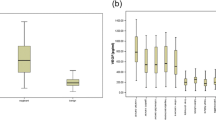Abstract
The aim of this study is to evaluate the performance of VEGF and endostatin levels in the differential diagnosis of malignant and benign ascites. The study included 101 consecutive patients with malignant ascites (55.2 ± 15.8 years, 63 men and 38 women) and 81 patients with benign ascites (53.0 ± 17.2 years, 51 men and 30 women). VEGF and endostatin levels in serum and ascites were determined by a sandwich enzyme immunoassay technique using a commercially available assay kit. The serum VEGF, ascites VEGF, and ascites endostatin levels of patients with malignant ascites were significantly higher than those in patients with benign ascites (P < 0.001), but there was no difference in serum endostatin levels between the two groups (P = 0.267). Ascites endostatin levels correlated positively with ascites VEGF (r = 0.5193, P < 0.01), and serum endostatin showed a low correlation with serum VEGF (r = 0.3291, P < 0.01) in patients with malignant ascites. Areas under the ROC curves of ascites VEGF, ascites endostatin, serum VEGF, and serum endostatin were 0.890, 0.815, 0.694, and 0.552, respectively. The combination of ascites VEGF and endostatin improved the sensitivity up to 90.1%, the specificity up to 87.7%, and the accuracy up to 89.0% in the differential diagnosis of malignant and benign ascites. VEGF and endostatin levels in ascites appear to be suitable for differentiating between malignant and benign ascites, which can be applied to clinical examination.



Similar content being viewed by others
Abbreviations
- VEGF:
-
Vascular endothelial growth factor
- ROC:
-
Receiver operating characteristic
- PPV:
-
Positive predict value
- NPV:
-
Negative predict value
References
Greco AV, Mingrone G, Gasbarrini G. Free fatty acid analysis in ascitic fluid improves diagnosis in malignant abdominal tumors. Clin Chim Acta. 1995;239(1):13–22.
McHutchison JG. Differential diagnosis of ascites. Semin Liver Dis. 1997;17(3):191–202.
Parsons SL, Lang MW, Steele RJ. Malignant ascites: a 2-year review from a teaching hospital. Eur J Surg Oncol. 1996;22(3):237–9.
Porcel A, et al. Value of laparoscopy in ascites of undetermined origin. Rev Esp Enferm Dig. 1996;88(7):485–9.
Yabushita H, et al. Vascular endothelial growth factor activating matrix metalloproteinase in ascitic fluid during peritoneal dissemination of ovarian cancer. Oncol Rep. 2003;10(1):89–95.
Kraft A, et al. Vascular endothelial growth factor in the sera and effusions of patients with malignant and nonmalignant disease. Cancer. 1999;85(1):178–87.
O’Reilly MS, et al. Endostatin: an endogenous inhibitor of angiogenesis and tumor growth. Cell. 1997;88(2):277–85.
Runyon BA. Care of patients with ascites. N Engl J Med. 1994;330(5):337–42.
Sherer DM, Eliakim R, Abulafia O. The role of angiogenesis in the accumulation of peritoneal fluid in benign conditions and the development of malignant ascites in the female. Gynecol Obstet Invest. 2000;50(4):217–24.
Garrison RN, Kaelin LD, Galloway RH, Heuser LS. Malignant ascites. Clinical and experimental observations. Ann Surg. 1986;203(6):644–51.
Gerbes AL, Jungst D. Role of cholesterol determination in ascitic fluid analysis. Hepatology. 2009;50(4):1320.
Zweig MH, Campbell G. Receiver-operating characteristic (ROC) plots: a fundamental evaluation tool in clinical medicine. Clin Chem. 1993;39(4):561–77.
Swets JA. Measuring the accuracy of diagnostic systems. Science. 1988;240(4857):1285–93.
Aslam N, Marino CR. Malignant ascites: new concepts in pathophysiology, diagnosis, and management. Arch Intern Med. 2001;161(22):2733–7.
Bamberger ES, Perrett CW. Angiogenesis in epithelian ovarian cancer. Mol Pathol. 2002;55(6):348–59.
Luo JC, Toyoda M, Shibuya M. Differential inhibition of fluid accumulation and tumor growth in two mouse ascites tumors by an antivascular endothelial growth factor/permeability factor neutralizing antibody. Cancer Res. 1998;58(12):2594–600.
Yoneda J, et al. Expression of angiogenesis-related genes and progression of human ovarian carcinomas in nude mice. J Natl Cancer Inst. 1998;90(6):447–54.
Nascimento I, et al. Vascular endothelial growth factor (VEGF) levels as a tool to discriminate between malignant and nonmalignant ascites. APMIS. 2004;112(9):585–7.
Sasaki T, Hohenester E, Timpl R. Structure and function of collagen-derived endostatin inhibitors of angiogenesis. IUBMB Life. 2002;53(2):77–84.
Gruszka A, Kunert-Radek J, Pawlikowski M, Stepien H. Serum endostatin levels are elevated and correlate with serum vascular endothelial growth factor levels in patients with pituitary adenomas. Pituitary. 2005;8(2):163–8.
Homer JJ, Greenman J, Stafford ND. Circulating angiogenic cytokines as tumour markers and prognostic factors in head and neck squamous cell carcinoma. Clin Otolaryngol Allied Sci. 2002;27(1):32–7.
Suzuki M, et al. Serum endostatin correlates with progression and prognosis of non-small cell lung cancer. Lung Cancer. 2002;35(1):29–34.
Yamagata M, et al. Serum endostatin levels in patients with hepatocellular carcinoma. Ann Oncol. 2000;11(6):761–2.
Feldman AL, et al. A prospective analysis of plasma endostatin levels in colorectal cancer patients with liver metastases. Ann Surg Oncol. 2001;8(9):741–5.
Lai R, et al. Clinical significance of plasma endostatin in acute myeloid leukemia/myelodysplastic syndrome. Cancer. 2002;94(1):14–7.
Feldman AL, et al. Serum endostatin levels are elevated and correlate with serum vascular endothelial growth factor levels in patients with stage IV clear cell renal cancer. Clin Cancer Res. 2000;6(12):4628–34.
Acknowledgments
This study was supported by a grant from the 2008 fund project of the Department of Education, Liaoning Province, China (Topic No: 2008752).
Author information
Authors and Affiliations
Corresponding author
Rights and permissions
About this article
Cite this article
Cheng, D., Liang, B. & Kong, H. Clinical significance of vascular endothelial growth factor and endostatin levels in the differential diagnosis of malignant and benign ascites. Med Oncol 29, 1397–1402 (2012). https://doi.org/10.1007/s12032-011-9972-2
Received:
Accepted:
Published:
Issue Date:
DOI: https://doi.org/10.1007/s12032-011-9972-2




